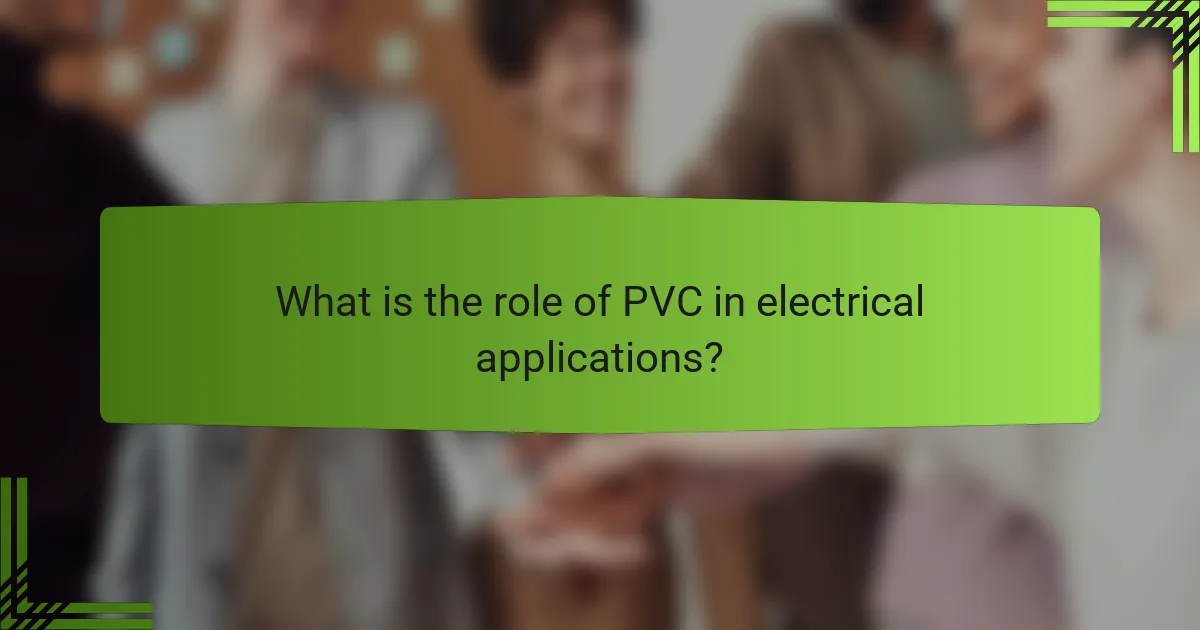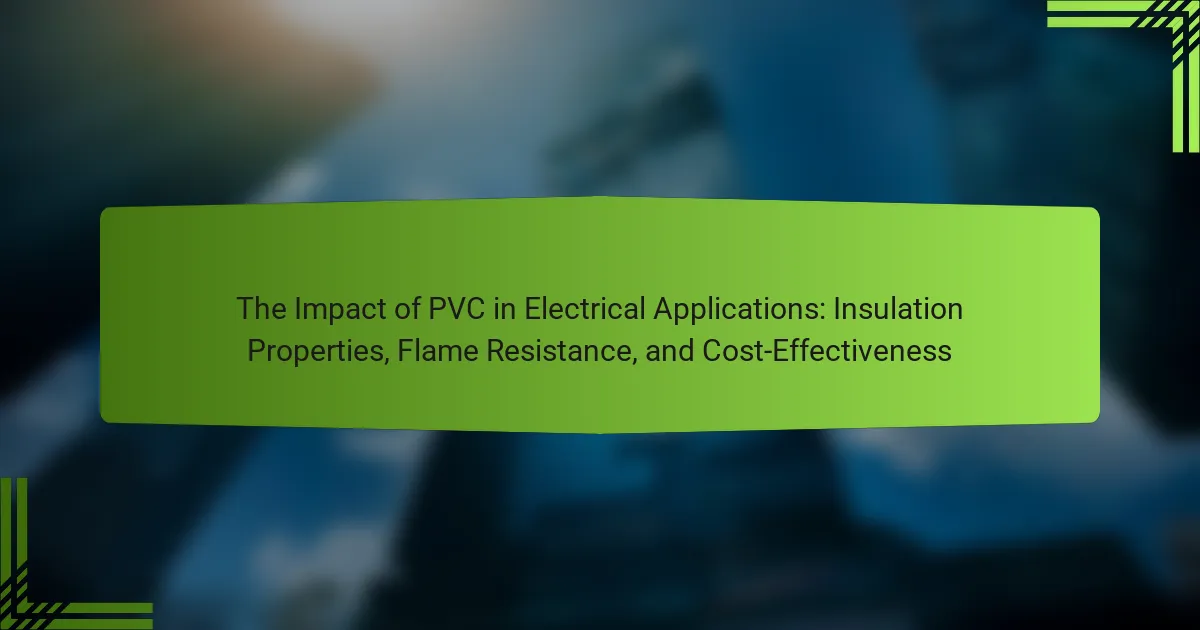PVC (polyvinyl chloride) is a crucial insulating material used in electrical applications due to its effective electrical insulation properties, which prevent current leakage and protect components. It is flame-resistant, reducing fire hazards, and exhibits durability and moisture resistance for long-lasting performance. The lightweight nature of PVC facilitates easier handling and installation, while its cost-effectiveness makes it a preferred choice over other insulation materials. Additionally, PVC’s versatility allows for a wide range of applications, including wires, cables, and connectors, highlighting its significant impact in the electrical industry.

What is the role of PVC in electrical applications?
PVC serves as an essential insulating material in electrical applications. It provides effective electrical insulation, preventing current leakage and protecting components. PVC is also flame-resistant, reducing fire hazards in electrical systems. Its durability and resistance to moisture contribute to long-lasting performance. The material is lightweight, making it easier to handle and install. Additionally, PVC is cost-effective compared to other insulation materials. Its versatility allows for various applications, including wires, cables, and connectors. These properties make PVC a preferred choice in the electrical industry.
How does PVC serve as an insulator in electrical systems?
PVC serves as an effective insulator in electrical systems due to its low electrical conductivity. This property prevents the flow of electric current, ensuring safety and efficiency in electrical applications. PVC, or polyvinyl chloride, has a high dielectric strength, which allows it to withstand high voltages without conducting electricity. Additionally, PVC is resistant to moisture and chemicals, further enhancing its insulating capabilities. Its ability to maintain performance in various environmental conditions makes it suitable for diverse electrical applications. The use of PVC insulation is widespread in cables and wiring, providing a reliable barrier against electrical hazards.
What specific insulation properties does PVC possess?
PVC possesses excellent electrical insulation properties. It has a high dielectric strength, typically around 20 kV/mm. This allows it to effectively prevent electrical conduction. PVC also exhibits low electrical conductivity, minimizing energy loss. Its thermal stability ensures performance under varying temperatures. The material is resistant to moisture, which enhances its insulating capabilities. Additionally, PVC is resistant to many chemicals, maintaining its integrity over time. These properties make PVC a preferred choice in electrical applications.
How does the thickness of PVC affect its insulation performance?
The thickness of PVC directly influences its insulation performance. Thicker PVC provides better electrical insulation due to increased resistance to electrical current. This resistance reduces the likelihood of electrical leakage and short circuits. Additionally, thicker layers of PVC can withstand higher temperatures without degrading. Research indicates that insulation performance improves significantly with increased thickness, enhancing safety in electrical applications. For instance, a study by the International Electrotechnical Commission shows that thicker PVC can handle voltages up to 10% higher than thinner variants. Thus, thickness is a critical factor in determining the effectiveness of PVC as an insulator.
What flame resistance characteristics does PVC exhibit?
PVC exhibits flame resistance characteristics such as self-extinguishing properties and low smoke generation. When exposed to flame, PVC does not sustain combustion. It has a limiting oxygen index (LOI) of around 28-30, indicating it requires a higher concentration of oxygen to burn. PVC’s chemical structure contains chlorine, which contributes to its flame retardancy. This chlorine content helps to inhibit the spread of flames. Additionally, PVC can form a protective char layer when burned, further limiting fire spread. These characteristics make PVC a suitable material for electrical insulation in applications where fire safety is a concern.
How does PVC compare to other materials in terms of flame resistance?
PVC has moderate flame resistance compared to other materials. It has a self-extinguishing property, meaning it can resist ignition and stop burning once the flame source is removed. In contrast, materials like polyethylene have lower flame resistance and can continue to burn. PVC’s flame resistance is enhanced by its chlorine content, which helps to inhibit combustion. When tested, PVC typically achieves a UL 94 rating of V-0 or V-1, indicating it can pass stringent flame tests. Other materials, such as polycarbonate, may offer better flame resistance but often at higher costs. Overall, while PVC is not the most flame-resistant material available, it provides sufficient safety for many electrical applications.
What are the implications of PVC’s flame resistance for safety standards?
PVC’s flame resistance significantly influences safety standards in various applications. Its inherent ability to resist ignition reduces the risk of fire hazards. This characteristic is crucial in electrical installations, where overheating can lead to fires. Safety standards often require materials to meet specific flame resistance ratings. PVC typically complies with these ratings, ensuring safer environments. For instance, the National Fire Protection Association (NFPA) sets guidelines that include flame resistance as a key criterion. Compliance with these standards can lower insurance costs and enhance overall safety. Thus, PVC’s flame resistance is integral to meeting and exceeding safety regulations in multiple industries.
Why is cost-effectiveness an important factor for PVC in electrical applications?
Cost-effectiveness is crucial for PVC in electrical applications because it reduces overall project expenses. PVC offers a lower material cost compared to alternatives like rubber or silicone. This affordability makes it a preferred choice for manufacturers and contractors. Additionally, PVC’s durability contributes to long-term savings by minimizing maintenance and replacement costs. Research indicates that using PVC can lower installation costs by up to 30%. Its lightweight nature also reduces shipping and handling expenses. Overall, the economic advantages of PVC enhance its viability in the electrical industry.
What are the cost comparisons between PVC and alternative materials?
PVC generally has a lower cost compared to many alternative materials. For instance, PVC can cost between $0.50 to $3.00 per square foot. In contrast, materials like polyethylene or polypropylene range from $1.00 to $5.00 per square foot. Additionally, metals like copper or aluminum can significantly exceed these costs, often ranging from $3.00 to $10.00 per square foot. PVC’s affordability stems from its widespread availability and lower production costs. This makes it a popular choice in electrical applications.
How does the lifecycle cost of PVC impact its adoption in the industry?
The lifecycle cost of PVC significantly influences its adoption in the industry. PVC offers low initial costs compared to alternative materials. Its durability leads to reduced maintenance expenses over time. Additionally, PVC’s energy efficiency during production and use contributes to lower overall lifecycle costs. According to a study by the Vinyl Institute, PVC can have a lifecycle cost savings of up to 30% compared to other materials. This economic advantage encourages industries to choose PVC for various applications. The combination of affordability and performance solidifies PVC’s position in the market.
How do insulation properties, flame resistance, and cost-effectiveness interrelate?
Insulation properties, flame resistance, and cost-effectiveness are interconnected in material selection. Effective insulation properties reduce energy loss, enhancing cost-effectiveness by lowering energy bills. Flame resistance is crucial for safety, preventing fire hazards in electrical applications. Materials that offer both insulation and flame resistance, like PVC, can be cost-effective due to their durability and performance. According to industry standards, PVC insulation can withstand high temperatures while maintaining its insulating properties. This combination makes PVC a preferred choice in electrical applications, balancing safety and economic factors effectively.
What are the practical applications of PVC in various electrical contexts?
PVC is widely used in electrical applications due to its excellent insulation properties. It serves as an insulating material for wires and cables, ensuring safety and efficiency. PVC is also utilized in the production of electrical conduits, which protect wiring systems from damage. The material’s flame resistance makes it suitable for use in environments where fire safety is a concern. Additionally, PVC is employed in switchgear and other electrical enclosures to provide insulation and protection. Its cost-effectiveness compared to other materials further enhances its practicality in various electrical contexts. The versatility of PVC allows it to meet diverse electrical application requirements effectively.
What best practices should be followed when using PVC in electrical installations?
Use PVC conduit that meets relevant electrical codes. Ensure proper sizing to accommodate wiring without strain. Install PVC in dry, well-ventilated areas to prevent moisture accumulation. Avoid exposing PVC to extreme temperatures or direct sunlight, as this can degrade the material. Secure PVC conduits with appropriate fittings and supports to prevent movement. Use non-corrosive adhesives and solvents for joining PVC components. Conduct regular inspections to identify any signs of wear or damage. Follow manufacturer guidelines for installation and maintenance to ensure safety and performance.
PVC, or polyvinyl chloride, is a crucial insulating material in electrical applications, known for its effective electrical insulation, flame resistance, and cost-effectiveness. This article explores PVC’s role in electrical systems, detailing its insulation properties, including low electrical conductivity and high dielectric strength, which prevent current leakage. Additionally, it examines PVC’s flame resistance characteristics, highlighting its self-extinguishing properties and compliance with safety standards. The economic advantages of PVC, including lower material costs and lifecycle savings, further solidify its position as a preferred choice in various electrical contexts. Practical applications and best practices for using PVC in electrical installations are also discussed to ensure safety and performance.


